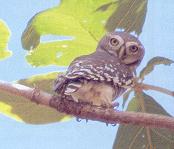Schedule I, Part III of the Indian Wildlife (Protection) Act, 1972 lists rare and endangered birds which are totally protected throughout the country, live or
dead or part thereof. They include Andaman Teal, Assam Bamboo Partridge, Bazas, Bengal Florican, Blacknecked Crane, Blood Pheasants, , Cheer Pheasant, Eastern White Stork, , Jerdon's Courser, Great Indian Bustard, Great Pied Hornbill, Hawks, Hooded Crane,
Hornbills, Houbara Bustard, Humes Bartailed Pheasant, Indian Pied Hornbill, Lammergeier, Large Falcons, Large Whistling Teal, Monal pheasant, Mountain Quail, Narcondam Hornbill, Nicobar Megapode, Nicobar Pigeon, Osprey, Peacock-Pheasant, Peafowl or Indian
Peafowl, Pinkheaded Duck, Scalter's Monal Pheasant, Siberian White Crane, Tibetan Snowcock, Tragopan-Pheasant, Whitebellied Sea Eagle, White-eared Pheasant, White Spoonbill, and Whitewinged Wood Duck.
 The Forest Spotted Owlet is a bird of the moist deciduous forest, but is also seen near streams. Though it is diurnal, it is very shy.
The Forest Spotted Owlet is a bird of the moist deciduous forest, but is also seen near streams. Though it is diurnal, it is very shy.
This little known bird of India was listed as an extinct species. However, the forest spotted owlet was rediscovered in Maharashtra in November 1997 by Dr. Pamela
Rasmussen, Scientist, Smithsonian Institution and her colleagues. During subsequent surveys conducted by Ms Farah Ishtiaq of Bombay Natural History Sociey (BNHS) in 1998, 14 birds have been located in two different sites in Maharashtra and further efforts
are being made to study the Ecology and Behaviour of the Forest Spotted owlet.
The forests of Taloda and Shahada in northern Maharashtra shot into prominence in 1997 with the rediscovery of the Forest Spotted Owlet Athene blewetti, thought
to be extinct for over a century. Before its rediscovery, no definite record of the species had been obtained since 1884. Surveys by BNHS have since established that a precarious population currently exists in the Taloda and Shahada forests.
Unfortunately, the forests of Taloda, have been identified as one of the rehabilitation sites for oustees (development refugees) of the Sardar Sarovar Project
(SSP) dam being built across the Narmada river in Gujarat. The government has asked for 1,500 ha. of forest land in five villages of Taloda. Thousands of trees have been marked for felling. The influx of oustees will take a toll of still more and will ruin
one of the few remaining habitats for the owlet.
The forest spotted owlett has often been confused with the spotted owlet which is widely distributed. in India. This is due to the similarity in size and spots
on the body. But the call of the forest owlet differs greatly from that of the spotted owlet. The call is like a "song" sweet and mellow, somewhat like the koel. The spotted owlet, on the other hand, has no call except for the screech call.
Photograph By - Farah Ishtiaque, BNHS